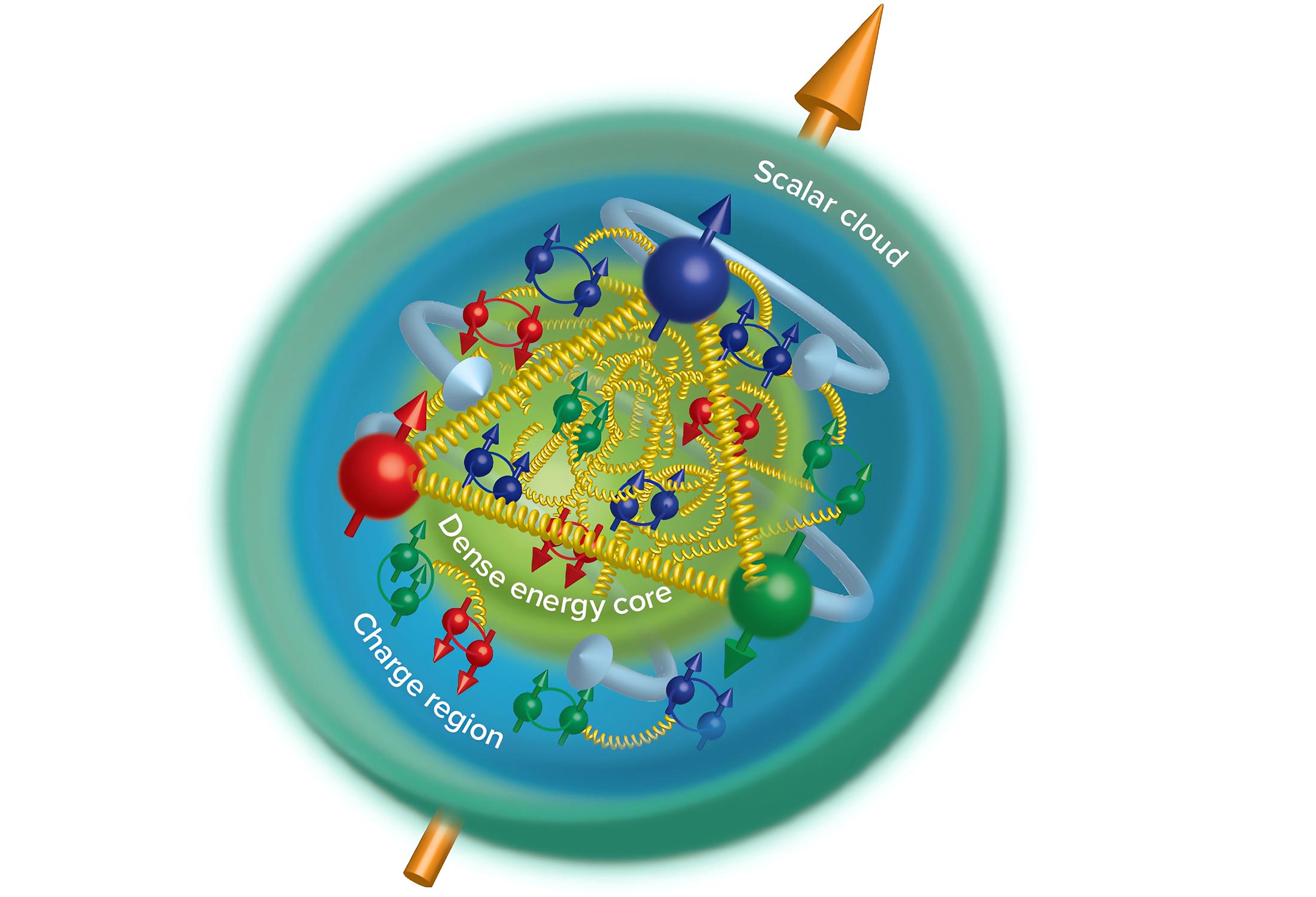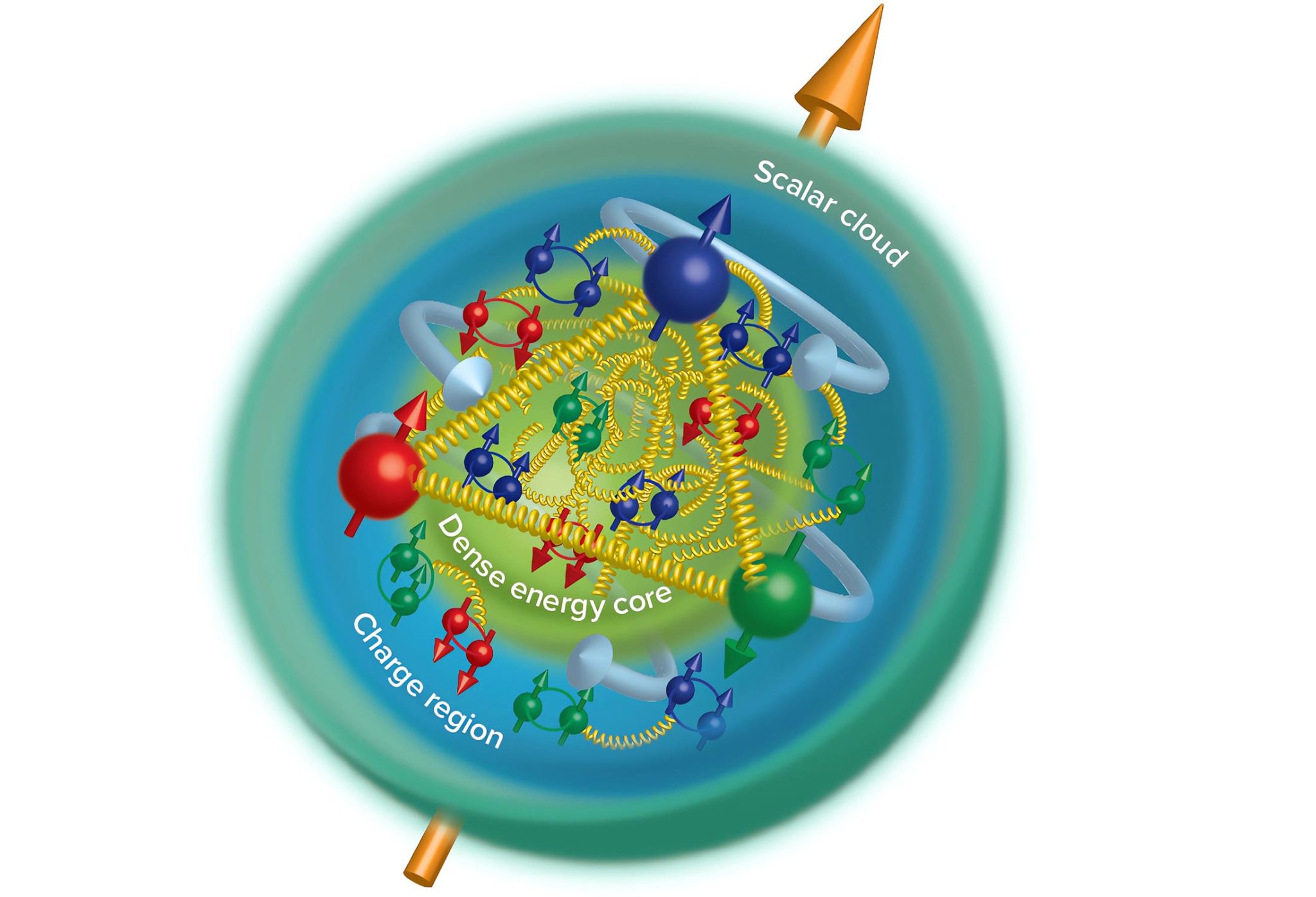

Bir protonun kütle yarıçapı, elektrik yükünün (yoğun çekirdek) yarıçapından daha küçükken, standart bir gluon aktivitesi bulutu, yük yarıçapının ötesine uzanır. Bu keşif, protondaki hapsetme ve kütle dağılımına ışık tutabilir. Kredi: Argonne Ulusal Laboratuvarı
Bir ‘cadı’ deneyi, bir protondaki bir gluonun kütlesini ortaya koyuyor
Protonun gluonik yerçekimi şekil faktörlerinin deneysel olarak tanımlanması, protonun gizli kütlesinin bir kısmını ortaya çıkarmış olabilir.
Nükleer fizikçiler sonunda, kütlesinin çoğunun bir protonun neresinde bulunduğunu saptamış olabilirler. ABD Enerji Bakanlığı’nın Thomas Jefferson Ulusal Hızlandırıcı Tesisi’nde yakın zamanda yürütülen bir deney, proton oluşturan kuarkları birbirine yapıştırırken güçlü kuvvet tarafından üretilen bir protonun kütle yarıçapını ortaya çıkardı. Sonuç 29 Mart dergisinde yayınlandı. doğa.
Protonun en büyük gizemlerinden biri, kütlesinin kökenidir. Bir protonun ölçülen kütlesinin sadece fiziksel yapı taşlarından, sözde üç değerlikli kuarklardan gelmediği ortaya çıktı.
DOE’nin Argonne Ulusal Laboratuvarı’nda deneysel bir fizikçi olan deney eş konuşmacısı Sylvester Justin, “Standart Model kuark kütlelerini bir protona eklerseniz, proton kütlesinin yalnızca küçük bir kısmını elde edersiniz” dedi.
Son birkaç on yılda nükleer fizikçiler, protonun kütlesinin birkaç kaynaktan geldiği sonucuna vardılar. Birincisi, kuarklarının kütlelerinden bir miktar kütle ve hareketlerinden biraz daha fazla kütle elde eder. Ardından, bu kuarkları birbirine yapıştıran güçlü bir kuvvet enerjisi kütlesi elde edersiniz ve bu kuvvet “gluonlar” olarak tezahür eder. Son olarak, kuarkların ve proton gluonların bir yığın dinamik etkileşimini elde edersiniz.
Bu yeni ölçüm, sonunda, bu gluonların ürettiği malzemenin yerini belirleyerek, proton gluonların ürettiği kütleye biraz ışık tutmuş olabilir. Maddenin çekirdeğinin bu yarıçapı, protonun merkezinde bulunur. Sonuç ayrıca, bu çekirdeğin bir protonun iyi ölçülmüş yük yarıçapından farklı bir boyuta sahip olduğunu gösteriyor gibi görünüyor; bu, genellikle bir protonun boyutu için bir vekil olarak kullanılan bir niceliktir.
Jefferson Lab’de Holes A&C deney sözcüsü Mark Jones, “Bu kütle yapısının yarıçapı yükün yarıçapından daha küçüktür ve bu nedenle bize çekirdeğin yük yapısına karşı kütle hiyerarşisi hakkında bir fikir veriyor” dedi. . Önder.
Enerji Bakanlığı’nın Argonne Ulusal Laboratuvarı’nda bir bilim adamı olan deneyin ortak yazarı Zainuddin Maziani’ye göre, bu bulgu aslında biraz sürpriz oldu.
“Bulduğumuz şey, bu şekilde gerçekten beklemediğimiz bir şeydi. Bu deneyin asıl amacı, araştırmacılar tarafından şu adreste bildirilen pentaquark’ı aramaktı:[{” attribute=””>CERN,” Meziani said
The experiment was performed in Experimental Hall C in Jefferson Lab’s Continuous Electron Beam Accelerator Facility, a DOE Office of Science user facility. In the experiment, energetic 10.6 GeV (billion electron-volt) electrons from the CEBAF accelerator were sent into a small block of copper. The electrons were slowed down or deflected by the block, causing them to emit bremsstrahlung radiation as photons. This beam of photons then struck the protons inside a liquid hydrogen target. Detectors measured the remnants of these interactions as electrons and positrons.
The experimenters were interested in those interactions that produced J/ Ψ particles amongst the hydrogen’s proton nuclei. The J/ Ψ is a short-lived meson that is made of charm/anti-charm quarks. Once formed, it quickly decays into an electron/positron pair.
Of the billions of interactions, the experimenters found about 2,000 J/ Ψ particles in their cross-section measurements of these interactions by confirming the coincident electron/positron pairs.
“It’s similar to what we’ve been doing all along. By doing elastic scattering of the electron on the proton, we’ve been getting the proton’s charge distribution,” said Jones. “In this case, we did exclusive photo-production of the J/ Ψ from the proton, and we’re getting the gluon distribution instead of the charge distribution.”
The collaborators were then able to insert these cross-section measurements into theoretical models that describe the gluonic gravitational form factors of the proton. The gluonic form factors detail the mechanical characteristics of the proton, such as its mass and pressure.
“There were two quantities, known as gravitational form factors, that we were able to pull out, because we had access to these two models: the generalized parton distributions model and the holographic quantum chromodynamics (QCD) model. And we compared the results from each of these models with lattice QCD calculations,” Meziani added.
From two different combinations of these quantities, the experimenters determined the aforementioned gluonic mass radius dominated by graviton-like gluons, as well as a larger radius of attractive scalar gluons that extend beyond the moving quarks and confine them.
“One of the more puzzling findings from our experiment is that in one of the theoretical model approaches, our data hint at a scalar gluon distribution that extends well beyond the electromagnetic proton radius,” Joosten said. “To fully understand these new observations and their implications on our understanding of confinement, we will need a new generation of high-precision J/ Ψ experiments.”
One possibility for further exploration of this tantalizing new result is the Solenoidal Large Intensity Device experiment program, called SoLID. The SoLID program is still in the proposal stage. If approved to move forward, experiments conducted with the SoLID apparatus would provide new insight into J/ Ψ production with the SoLID detector. It will really be able to make high-precision measurements in this region. One of the major pillars of that program is J/ Ψ production, along with transverse momentum distribution measurements and parity-violating deep inelastic scattering measurements,” Jones said.
Jones, Joosten and Meziani represent an experimental collaboration that includes more than 50 nuclear physicists from 10 institutions. The spokespeople also want to highlight Burcu Duran, the lead author and a postdoctoral research associate at the University of Tennessee, Knoxville. Duran featured this experiment in her Ph.D. thesis as a graduate student at Temple University, and she was a driving force behind the analysis of the data.
The collaboration conducted the experiment over about 30 days in February-March 2019. They agree that this new result is intriguing, and they say that they all are looking forward to future results that will shed additional light on the glimpses of new physics that it implies.
“The bottom line for me – there’s an excitement right now. Could we find a way to confirm what we are seeing? Is this new picture information going to stick?” Meziani said. “But to me, this is really very exciting. Because if I think now of a proton, we have more information about it now than we’ve ever had before.”
Reference: “Determining the gluonic gravitational form factors of the proton” by B. Duran, Z.-E. Meziani, S. Joosten, M. K. Jones, S. Prasad, C. Peng, W. Armstrong, H. Atac, E. Chudakov, H. Bhatt, D. Bhetuwal, M. Boer, A. Camsonne, J.-P. Chen, M. M. Dalton, N. Deokar, M. Diefenthaler, J. Dunne, L. El Fassi, E. Fuchey, H. Gao, D. Gaskell, O. Hansen, F. Hauenstein, D. Higinbotham, S. Jia, A. Karki, C. Keppel, P. King, H. S. Ko, X. Li, R. Li, D. Mack, S. Malace, M. McCaughan, R. E. McClellan, R. Michaels, D. Meekins, Michael Paolone, L. Pentchev, E. Pooser, A. Puckett, R. Radloff, M. Rehfuss, P. E. Reimer, S. Riordan, B. Sawatzky, A. Smith, N. Sparveris, H. Szumila-Vance, S. Wood, J. Xie, Z. Ye, C. Yero and Z. Zhao, 29 March 2023, Nature.
DOI: 10.1038/s41586-023-05730-4
Funding: DOE/US Department of Energy

“Analist. Tutkulu zombi gurusu. Twitter uygulayıcısı. İnternet fanatiği. Dost pastırma hayranı.”





More Stories
Bilim insanları dünyadaki en büyük demir cevheri yataklarında milyar yıllık bir sırrı keşfetti
Fosillere göre tarih öncesi deniz ineği, timsah ve köpekbalığı tarafından yenildi
Büyük bir bindirme fayı üzerine yapılan yeni araştırma, bir sonraki büyük depremin yakın olabileceğini gösteriyor